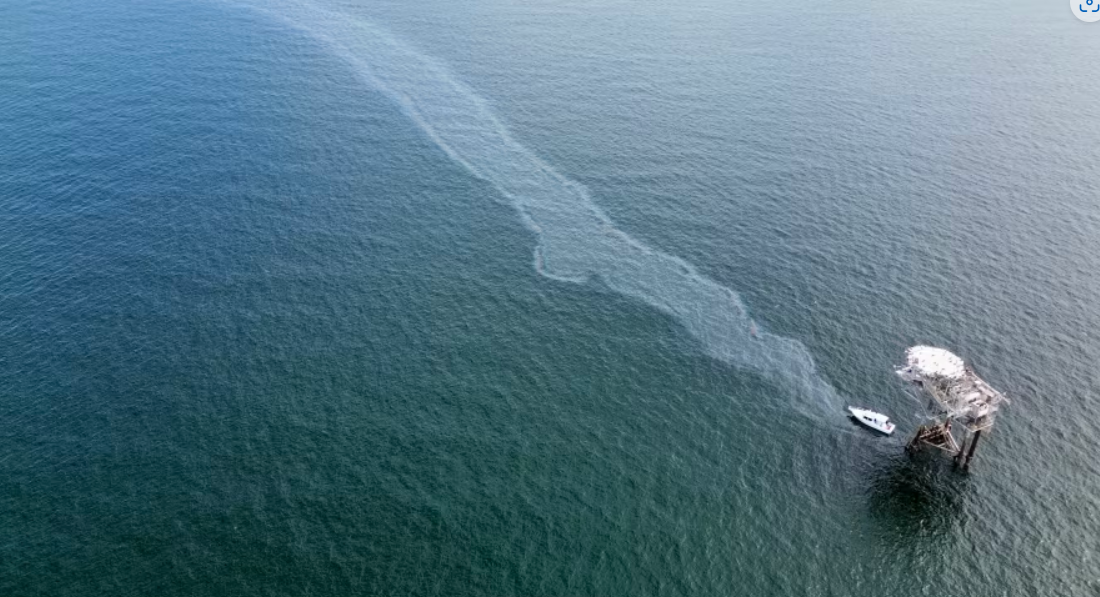
Natural Gas and Oil Discharge Detected Off Crystal Beach: A Developing Situation
Ashton RouthierShare
Overview
On Sunday, July 14, 2024, at 8:00 pm, the Oil Spill La Porte Office Response Officer received an urgent notification about a significant natural gas and oil discharge off the coast of Crystal Beach, Galveston County. The natural gas and oil discharge off the coast of Crystal Beach is a developing situation requiring coordinated efforts from multiple agencies. Continued monitoring, research, and public communication are essential to mitigate the environmental impact and address regulatory concerns. As investigations proceed, the focus remains on ensuring the safety and integrity of the Gulf of Mexico's coastal and marine ecosystems.

Incident Overview
On Sunday, July 14, 2024, at 8:00 pm, the Oil Spill La Porte Office Response Officer received an urgent notification about a significant natural gas and oil discharge off the coast of Crystal Beach, Galveston County. The spill was reported to have originated from a platform situated in High Island Block 98-L, approximately eight miles offshore in the Gulf of Mexico. This alert triggered an immediate response, highlighting the severity and potential environmental impact of the discharge. Given the platform's offshore location, the situation demanded swift action to assess the scope of the leak and initiate containment measures. The initial report underscored the critical nature of the incident, prompting coordinated efforts from various agencies to address the emerging environmental threat.
Initial Response and Findings
The following Monday morning, Oil Spill personnel promptly responded to the notification by traveling via response boat to investigate the reported discharge off the coast of Crystal Beach. Upon inspection, they discovered that the discharge was emanating from a flowline riser, leaking natural gas and condensate, which are substances posing significant environmental risks. While the leak was visible from the water, no recoverable oil was detected, indicating that traditional oil spill response techniques would not be applicable. The platform in question, classified as abandoned, falls under the statutory authority of the Texas Railroad Commission. However, the wells associated with this platform are not included in the current well-plugging memorandum of understanding (MOU) between the Texas Railroad Commission and the General Land Office (GLO). This regulatory gap introduces additional challenges, requiring coordinated efforts among various agencies to mitigate the environmental impact and secure the site effectively.
Follow-Up Inspection and Current Status
On Wednesday, July 17, staff from the La Porte office, accompanied by personnel from the US Coast Guard and the Railroad Commission, conducted a follow-up inspection of the platform area to reassess the situation and determine the progress of the initial response efforts. Upon arrival, they observed that the leak from the flowline riser persisted but had not increased in severity, indicating a stable but ongoing discharge of natural gas and condensate. Despite the continued presence of the leak, no new environmental damage was evident, suggesting that immediate containment measures might have been somewhat effective. However, the Railroad Commission staff emphasized the need for further research to fully determine the ownership and responsibility for the source of the leak. This step is crucial for legal and administrative purposes, as identifying the responsible parties will help streamline the efforts to stop the leak and facilitate accountability. The joint inspection underscored the importance of multi-agency collaboration in managing and mitigating the impacts of such environmental incidents.
Public Awareness and Media Coverage
The Coast Guard reported receiving a call from Channel 2-KPRC (NBC) in Houston regarding the leak, indicating that the incident had garnered significant media attention. This call from a major news outlet highlights the public's growing concern and the urgency for transparent communication and effective action. Additionally, the incident has gained considerable attention on social media, particularly from a local fishing group that has been actively posting updates and raising awareness about the potential environmental impact on the Gulf's marine life and coastal areas. The public awareness and media interest underscore the significance of the leak, emphasizing the critical need for ongoing monitoring and resolution. This heightened visibility not only pressures the involved agencies to act swiftly and efficiently but also plays a crucial role in mobilizing community support and resources for the mitigation efforts. The broadening attention serves as a reminder of the environmental, economic, and social stakes involved, necessitating a coordinated response to address and resolve the issue promptly.
Environmental and Regulatory Implications
The abandonment status of the platform and associated wells, as documented in the Oil Spill program's abandoned well listings, raises significant concerns about regulatory oversight and potential environmental impact. These abandoned wells and platforms, often left without proper maintenance or monitoring, pose serious risks, including leaks and spills that can harm marine and coastal ecosystems. The involvement of the Texas Railroad Commission is crucial for addressing the current leak and ensuring that all activities comply with environmental regulations. The Commission's role involves not only managing the immediate response but also implementing long-term solutions to prevent future incidents. This situation highlights the inherent challenges and responsibilities in managing abandoned oil and gas infrastructure. It underscores the need for stringent regulatory frameworks, regular inspections, and proactive measures to secure abandoned sites.
source: https://www.facebook.com/TerriLeoWilson/posts/502336435649886?ref=embed_post